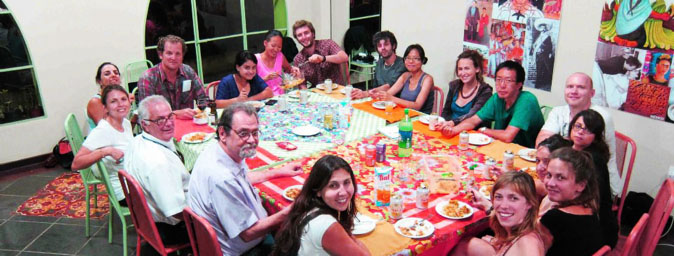This is the student blog documenting the master’s field trip to Brazil to continue work on the Rio Floods Petropolis Sports-for-Change project in Brazil, in collaboration with Architecture for Humanity. Click here for the entire series.
————————————
Today is the final day of our field trip; our last day in Brazil. After this vivid and fascinating week filled with meetings, design planning discussions and presentations, the fieldtrip has come to a satisfying end. Nathaniel and Alix from Architecture for Humanity departed our group earlier in the morning. As we started to pack and greeted the valley with a last lunch, Ella Chau was working on a documentary, filming interviews about our personal impressions and feelings during the workshop.
Our field trip experience was generally very positive. Working in groups with different viewpoints was an interesting way to exchange opinions and design concepts. Seeing how Architecture for Humanity handles this type of project involving all the stakeholders in a comprehensive manner, and understanding and motivating the choice of a soccer field as a post-disaster regenerator was stimulating. Professionals and community members reacted with useful information and suggestions, coming from a deeper knowledge of the place. We were very pleased to receive the architect Demetre Anastassakis (Autografics Arquitetura e Planejamento) on the previous day; his opinions were crucial from a technical standpoint and his critique was enlightening.

Dinner with architect Demetre Anastassakis
Our ideas and proposals for the community space in the post-emergency housing complex transformed since our first approach in Barcelona during the workshop. When we visited the site, the terrain was different from the plan we had studied. A huge cut on the top of the hill changed our previous perception on the topography, and we tried to adapt our proposals to the plot.
We departed from Itaipava at 15.00, admiring on our busride the Rio de Janeiro skyline, the contrasting dimensions of its neighbourhoods, the city’s symbols and its amazing landscape.
When we arrived at the airport our group split up, ready to venture out to different corners of the world to accomplish our internships. Three other colleagues and I continued the trip to downtown Rio de Janeiro, where we will spend several days exploring the city and its most iconic event, Carneval. For me this is a unique opportunity, given that the topic of my thesis focuses on events as urban regenerators and the differences in urban policies between developed and developing countries.
We will stay in Brazil until May working in an internship at the São Bernardo do Campo Municipality in collaboration with the Cities Alliance slum-upgrading program, on which we will be basing our thesis.





Why not have these kinds of programmes with local students? Brazilian architecture schools are full of competent professionals who know the local realities, its history and other social issues that technical knowledge alone is not capable of resolving. Brazilian history is full of models brought from Europe that, obviously, did not resolve any problems and, more likely, created more. Once again, it seems like it is a matter of the “developed” saving the “underdeveloped”.
hi Roberta, we agree that local is best and that schools should promote workshops in their own countries. Nevertheless, we are a school based in Europe, with a wide range of students from around the world (often from those countries) and also believe in the importance of training students in developing/foreign contexts as they can contribute their skills at the same time that they can learn from local practitioners; it’s a matter of knowledge exchange and enrichment, rather than ‘developed saving the underdeveloped’, which is certainly not our approach. Having said that, our program also participates in local projects.
thank you so much for visiting the blog and for your comments!